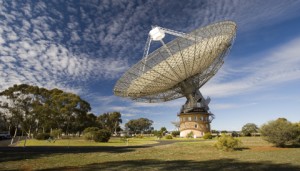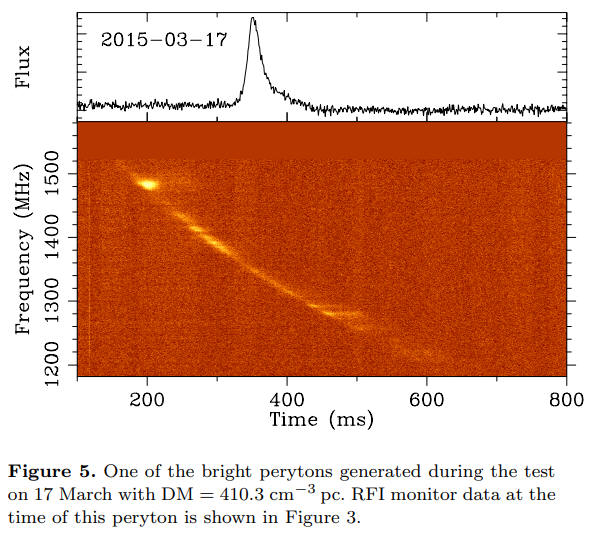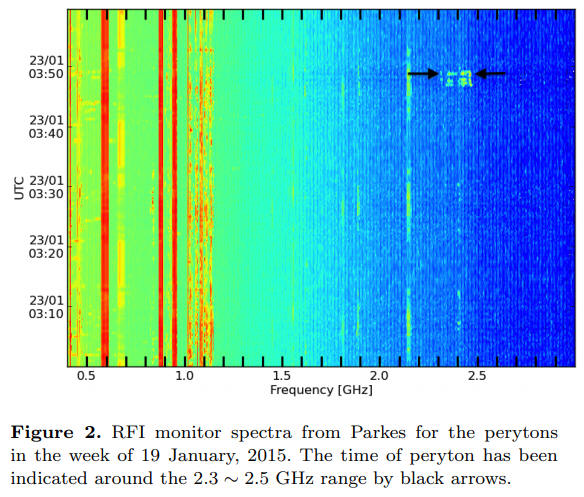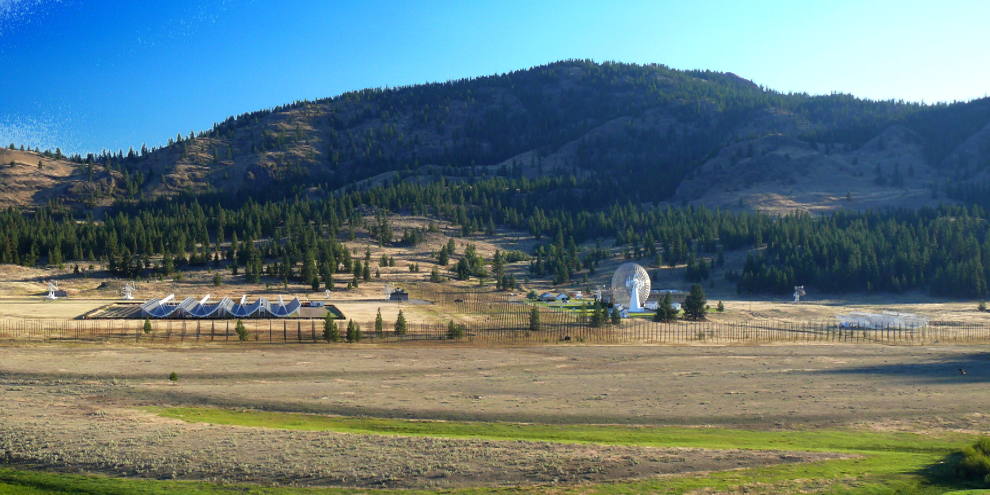ALIEN CIVILIZATION AND MICROWAVE OVENS
科研趣闻:
17年前,澳大利亚Parkes射电天文望远镜发现奇异无线脉冲信号,科学家将此信号命名为“Perytons”。它也许是来自一种外星文明的暗示,人类迫切需要将其解码,确认是否对地球构成威胁。外星文明探索始终关乎人类未来命运,于是科学家们开始全力探索,但经过17年艰苦努力,最终发现信号来自实验室的两台微波炉,是微波炉在特殊使用条件下偶然发出的波形。发现这一结论后,科学家将这一结论发表了一篇总结论文:Emily Petroff et al. “Identifying the Source of Perytons at the Parkes Observatory.” Posted to arXiv.org April 9, 2015. 研究结论虽然出乎预料,但探索过程发表的多篇论文推动了射电天文信号探测领域的进步。
故事的原始报道及论文原文如下:
MICROWAVE OVENS SPARK RADIO SIGNALS
After 17 years, researchers using the Parkes radio telescope in Australia have identified the culprit behind a mysterious type of radio signal: two on-site microwave ovens.
17年后,澳大利亚帕克斯射电望远镜的研究人员发现了一种神秘的无线电信号背后的罪魁祸首:两台实验室的微波炉。

The 64-meter Parkes radio telescope in Australia is usually silent. Astronomers control the radio dish, slewing it from horizon to horizon, from off-site locations. Occasional staff workers might meander through the halls during the day. But otherwise, the facility is as quiet as the universe it observes.
澳大利亚的64米帕克斯射电望远镜一直默默地工作着。天文学家控制着巨型的射电抛物面天线,左右沿着不同平面扫描。白天员工们偶尔在大厅里经过或交谈,除此之外,这套科研设施就像它观察到的宇宙一样安静。
But on one particular day in mid-March, the facility was bustling with activity. Astronomers weren’t, however, huddled around the radio dish. They were gathered around a microwave oven in the facility’s kitchen. The observers were continuously heating and re-heating a cup of water in order to test the microwave’s effect — if any — on the colossal dish nearby.
直到3月中旬的某一天,这里急切地忙碌起来,然而天文学家们并没有忙于控制抛物面天线,他们聚集在实验室厨房的微波炉旁,不断地用微波炉加热一杯又一杯的水,以测试微波炉对附近射电天线的影响。
The reason dates back 17 years, when astronomers first spotted fleeting bursts of radio signals in their data.
这可追溯到17年前,当时天文学家首次在他们的数据中发现了稍纵即逝的无线电信号。
Emily Petroff (Swinburne University of Technology, Australia) says that the discovery team knew early on that these so-called perytons were local. The observatory watches along 13 different radio beams as the dish sweeps across the sky. Any point-like astrophysical source will be brightest at just one of those frequencies. Perytons, however, appear equally bright in all 13 beams.
The fact that perytons only appeared in data gathered by the Parkes telescope also suggested the source was local. But the team didn’t know just how local perytons might be. Theories about the signals’ origins included lightning, satellites, and any of the various electronics on site. “There are many potential offenders,” says Sarah Burke-Spolaor (National Radio Astronomy Observatory). “We just had no clear idea where to start testing.”
Then Petroff, Burke-Spolaor, and their colleagues installed a real-time radio interference monitor late last year. In January, the telescope detected three of the signals and the interference monitor also picked up three signals at 2.3 to 2.5 GHz, the same frequency range that a microwave oven runs on.
So on that fateful day in March, the astronomers found themselves continually testing and re-testing a nearby microwave oven. Still, they couldn’t re-create a peryton. But when they opened the oven’s door prematurely, the signal appeared. They had unleashed a small but powerful radio signal.
The perytons were likely caused by staff members who were too impatient to wait for their lunches to finish heating. “We were quite surprised about this,” says Petroff. “It turned out to be something so simple and so close! It felt pretty good to solve the mystery.”
With One Mystery Solved, Another Unfolds
Sensitive radio telescopes, like the one at Parkes, can easily detect rogue radio signals. And human interference is a common frustration for radio astronomers. In the telescope’s early days, Burke-Spolaor often found herself observing poor data only to find that someone at the visitor’s center was on his cell phone or the bathroom’s toilets were continuously flushing.
Recently, astronomers even voiced concerns over a plan to design robotic lawn mowers that would run on radio waves.
The perytons in particular interfered with this team’s main mission: to understand the source of fast radio bursts, brief but brilliant signals with potential extragalactic origins. Both perytons and fast radio bursts have a distinct look to them, in that their lower frequencies arrive noticeably later than their higher ones.
Typically, this dispersion is created when light travels through dense clouds of electrons in extragalactic space. Lower frequencies (longer wavelengths) of radio emission interact more with the electrons than higher frequencies do, and so the lower frequencies end up delayed, like an extrovert trying to leave a party. The higher the time delay, the further the signal has traveled. Most astronomers think fast radio bursts originate as far as 10 billion light-years away.
But seeing a terrestrial signal exhibit this same effect worried astronomers. It didn’t help that the first fast radio burst discovered had a nearly identical time delay to the perytons.
Astronomers now know of several fast radio bursts, and they’re certain that perytons and bursts are two different phenomena. Not only do perytons always exhibit the same time delay (one typical of a microwave oven), but they also tend to cluster around lunchtime, says Petroff. Fast radio bursts, on the other hand, occur at random, with a range of time delays because they’re coming from a range of cosmic distances.
With the mystery settled, Petroff and her colleagues can focus on the origins of fast radio bursts. It’s still unclear how these enigmatic bursts are created — perhaps when an incredibly fast-spinning magnetar throws off flares, or two dense neutron stars collide. Either way, it’s likely to be far more exciting than a microwave oven.
Reference:
Emily Petroff et al. “Identifying the Source of Perytons at the Parkes Observatory.” Posted to arXiv.org April 9, 2015.
论文PDF原文下载:
Identifying the source of perytons at the Parkes radio telescope (下载3759 )文中时频联合分析和RFI监视:


IEEE Spectrum report:
Microwave Ovens Posing as Astronomical Objects —Did microwave ovens lead astronomers astray?
By Alexander Hellemans
后面的FRB检测还会是微波炉吗?
BBC报道: 来自遥远深空的神秘信号

Mysterious radio signals from deep space detected – BBC News
Jan 09, 2019 https://www.bbc.co.uk/news/science-environment-46811618
2019年1月9日,加拿大科学家接收到15亿光年外的无线电讯号,且在短短3周内他们监测到了13个快速电波爆发(fast radio burst,FRB),其中有一个非常不同寻常的重复讯号,且与先前监测的另一讯号的内容特性相似。由于这些讯号不断爆发传送,像是在告诉地球人什么讯息一样,让科学家都相当好奇这些讯号想表达什么,正在分析其状况。FBR的巨大能量可能来自黑洞或中子星碰撞造成,推测是银河系外异常高能量的脉冲色散,但也有科学家相信这些信号很有可能是外星智慧的迹象。
Fast radio bursts, or FRBs as they’re known, last for just a thousandth of a second. But what they lack in duration, they more than make up for in power. Astronomers have detected them from distant galaxies that are billions of trillions of miles away.
快速射电暴,又称 “FRBs”,只持续千分之一秒。但它们在持续时间上所缺乏的,在力量上完全可以弥补。天文学家已经在数万亿英里之外的遥远星系中发现了它们。
Researchers have no clear explanation for how they are formed, but theories ranged from the far-fetched, that they’re pulses powering alien starships, to the relatively prosaic, that they are a result of the collision of two dying stars.
研究人员对它们是如何形成的还没有明确的解释,但各种理论五花八门,有的说它们的脉冲驱动着外星飞船,有的说它们是两颗濒死恒星碰撞的结果,前者的理论令人难以置信,后者的相对平淡无奇。
The mystery deepened last year with the detection of a repeated FRB from the same location, which ruled out the idea that this was the result of a destructive process. Now, Dr Shriharsh Tendulkar and colleagues at McGill University in Montreal have discovered a second repeating FRB.
去年,这个谜团随着在同一地点检测到的一个反复出现的 FRB 进一步加深,也因而排除了认为这是一个破坏过程结果的观点。现在,蒙特利尔麦吉尔大学的施里哈什·坦杜卡博士和他的同事们发现了第二种重复快速射电暴。
What’s especially exciting about fast radio bursts is that they interact with every electron and every magnetic field they encounter on their intergalactic journey. This means that embedded within these bursts is a record of their voyage across deep space. And so FRBs can in effect, be used as probes to study the distant galaxies from which they come.
特别令人兴奋的是,快速射电暴与它们在星际旅行中遇到的每一个电子和每一个磁场都相互作用。这意味着在这些爆炸中嵌有它们穿越深空航行的记录。所以,事实上,快速射电暴可以作为探测工具来研究它们所来自的遥远星系。
Reference:http://www.voanews.cn/bbc/51804.htm
Nature 文章报道
Amiri, M., Bandura, K., Bhardwaj, M. et al. A second source of repeating fast radio bursts. Nature 566, 235–238 (2019) https://www.nature.com/articles/s41586-018-0864-x
原文:https://rdcu.be/b5b3U
Amiri, M., Bandura, K., Bhardwaj, M. et al. Observations of fast radio bursts at frequencies down to 400 megahertz. Nature 566, 230–234 (2019)
https://www.nature.com/articles/s41586-018-0867-7
原文:https://rdcu.be/b5b3P